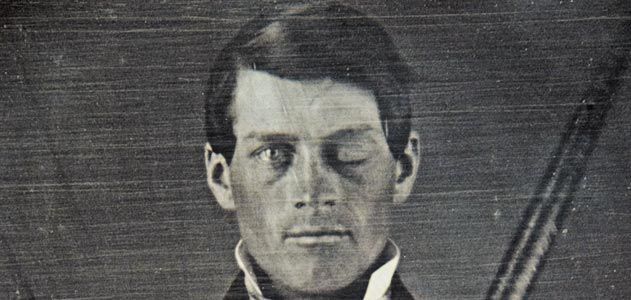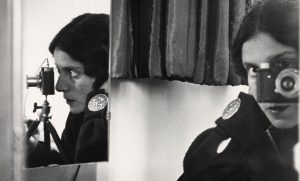It was not an extraordinary day in Cavendish, Vermont. To most people, this day was perfectly normal. September 13, 1848 was just another Wednesday. Phineas Gage, a foreman working for Rutland & Burlington Railroad, would have agreed that this day was no different from any other. Or, at least that’s how it started.1
On this day in September 1848, Gage was only 25 years old. Gage, by all means, was not extraordinary. He was very average. He stood at 5 feet 6 inches, and he was physically strong, as was needed for his job. He was kind, well-mannered, intelligent, and had a good temper. On this day, Gage was putting explosive powder into an iron. It was part of his job, and something he had done before. Gage, a cautious man, usually paid attention to what he was doing. For some reason, he turned his head for a second. He looked away. That was all it took. In one second, his life changed forever.2
The powder Gage was putting into the iron activated, causing an explosion. Surprised, he didn’t have a time to react. The force blew him from where he was standing, and he landed a couple of feet away from his original position. The iron rod went through his left cheek and then out of his skull. Days later it was found by Gage’s men, about 80 feet away from where Gage landed, smeared with blood and brain.3

Miraculously, Gage didn’t pass out from the impact or the bleeding. He got up, went to the town, went into a hotel, and waited there for a doctor. All with little help. When the local doctor arrived, Gage spoke to him and said, “Doctor, here is business enough for you.” Dr. Williams couldn’t believe him — if his story was true and an iron went through his head, how was Gage still standing and talking? How was he fully conscious? It wasn’t until an Irishman standing nearby added to their conversation, stating the rod was still on the floor over by the railroad, “all blood and bits,” that Dr. William believed him.4
Dr. Williams, realizing he wasn’t exactly qualified to treat Gage’s injury called over Dr. John Harlow. In today’s terms, calling Dr. Harlow a neurosurgeon wouldn’t be correct. At this time, neuroscience wasn’t even known, much less an actual field of study. Still, Dr. Harlow treated Gage and managed to stop the hemorrhage Gage had. Even though Phineas Gage experienced severe trauma, he didn’t seem very bothered, nor did he show any signs of stress. Gage even told the doctor that he didn’t want his friends or family to come visit him. After all, his accident wasn’t very serious, and he would return to work in a couple of days time. Through this process, Gage was conscious, and the traces left by the iron and rust were a testament to his accident.5
It took a while for Gage to recover. Not surprisingly. Dr. Harlow kept a clear record of his whole treatment. He kept an almost day-by-day journal filled with his observations, as well as the treatment Gage was receiving. He had an infection, but as Dr. Harlow treated it, it went away fairly quickly. At times during his recovery, Gage would sometimes seem delirious, but that would clear up almost immediately. It was remarkable.6 Really, no one would have guessed what was truly wrong with him until they analyzed him fully. On top of his head, there was an inverted tunnel showing where the rod had come out of. On his left cheek, there was a hole. Small pieces of Gage’s brain appeared scattered throughout his scalp, stuck to his hair. Dr. Harlow described in his report later on, that as he pressed against Gage’s skull, “The pulsations of the brain were distinctly seen and felt.”7 A month later, Gage was able to stand and walk around. Neurologically, he appeared in tact.

The news of his accident quickly spread. Soon enough, Gage was the main topic for articles in his town. This, however, was not what lead to his fame, in fact, Gage wasn’t exactly flourishing after this accident. It was the opposite.
Physically, he wasn’t much different than before. He was still physically capable, although his left eye would stay shut forever, and the left side of his face was partially paralyzed.8 Dr. Harlow would even go so far as to say he had fully recovered. Gage stated he felt fine, but he had an odd feeling. But, it was a feeling not even he could describe. He had no pain, but something was different in his head.9

Even though he was physically capable of doing most things, he couldn’t hold down a job. His old employer refused to hire him again. Something had changed, and it wasn’t in Gage’s physical performance. After the accident everyone collectively agreed, “Gage was no longer Gage.”10 Dr. Harlow detailed these changes. Reportedly, Gage’s personality and behavior drastically changed. The capable and efficient man people hired and knew was gone. He was replaced by a different type of man. Gage now used profanity, something he hadn’t done before. He showed little emotion or care for his coworkers and previous friends. He was irrational, with a short temper.11

Years after the accident, Gage continued to find himself unemployed. His ill-advised decisions caused by his new personality didn’t land him very far. Instead, Gage sought other ways to make money.12 He exhibited himself as a circus act, carrying the famous iron rod. Of course, every job he held was short lived, and he wasn’t a circus act his whole life. He also traveled traveled. He went from through New England, all the way to Chile. His jobs were mostly manual types of work, like driving a stagecoach. Throughout all his travels, he carried the rod with him, like it was a part of him, his only companion.13
In 1860, at the young age of 36, Gage began to experience seizures. He returned home to California, where he reunited with his mother and sister, his only family. Dr. Harlow would later report that after every epileptic convulsion, Gage had no memory of them. Eventually, on May 21st, 1860, after a series of continuous seizures, Phineas Gage died. It was exactly, “twelve years, six months and eight days after the date of his injury.”14

Phineas Gage’s story, as well as the later exhumation of his bones, led to the discovery and subsequent explorations of the brain. His story is one that’s commonly looked at, and it is referred to as “Neuroscience’s most famous case.”15 It led to advancements in what we now know about brain injuries, and how to treat them. Still, sometimes Phineas Gage himself is forgotten. He should be remembered not just as a case, or as an interesting phenomenon, but as a person. He was a good-looking, kind, confident, assertive, young man.16 He had a family, friends, and lived a good life. He was an ordinary man, who experienced an extraordinary injury. And, we should never forget him for that.
- John Martyn Harlow, “Recovery from the passage of an iron bar through the head,” Publications of the Massachusetts Medical Society 2, no. 3 (1868): 4. ↵
- John Martyn Harlow, “Recovery from the passage of an iron bar through the head,” Publications of the Massachusetts Medical Society 2, no. 3 (1868): 4. ↵
- TL Guidotti, “Phineas Gage and His Frontal Lobe- The “American Crowbar Case”,” Archives of Environmental & Occupational Health 67, no. 4 (2012): 249. ↵
- Malcolm Macmillan, Odd Kind of Fame: Stories of Phineas Gage (Cambridge: MIT Press, 2000), 43-44. ↵
- John Martyn Harlow, “Recovery from the passage of an iron bar through the head,” Publications of the Massachusetts Medical Society 2, no. 3 (1868): 7. ↵
- Andrew Grieve, “Phineas P Gage—‘The man with the Iron bad’,” Trauma 12, no 3 (2010): 172. ↵
- John Martyn Harlow, “Recovery from the passage of an iron bar through the head,” Publications of the Massachusetts Medical Society 2, no. 3 (1868): 5. ↵
- TL Guidotti, “Phineas Gage and His Frontal Lobe- The “American Crowbar Case”,” Archives of Environmental & Occupational Health 67, no. 4 (2012): 249-250. ↵
- John Martyn Harlow, “Recovery from the passage of an iron bar through the head,” Publications of the Massachusetts Medical Society 2, no. 3 (1868): 12. ↵
- TL Guidotti, “Phineas Gage and His Frontal Lobe- The “American Crowbar Case”,” Archives of Environmental & Occupational Health 67, no. 4 (2012): 249-250. ↵
- John Martyn Harlow, “Recovery from the passage of an iron bar through the head,” Publications of the Massachusetts Medical Society 2, no. 3 (1868): 11-12. ↵
- Encylopedia of Social Psychology, 2007, s.v. “Social Cognitive Neuroscience,” by Matthew D. Lieberman. ↵
- TL Guidotti, “Phineas Gage and His Frontal Lobe- The “American Crowbar Case”,” Archives of Environmental & Occupational Health 67, no. 4 (2012): 249-250. ↵
- John Martyn Harlow, “Recovery from the passage of an iron bar through the head,” Publications of the Massachusetts Medical Society 2, no. 3 (1868): 14. ↵
- Andrew Grieve, “Phineas P Gage—‘The man with the Iron bad’,” Trauma 12, no 3 (2010): 173. ↵
- TL Guidotti, “Phineas Gage and His Frontal Lobe- The “American Crowbar Case”,” Archives of Environmental & Occupational Health 67, no. 4 (2012): 250. ↵




50 comments
Samantha Bonillas
This case study changed the game for science and psychology today. In my opinion, without this horrific incident of Phineas Gage, psychologist would not have made the discoveries that they discovered with Gage’s study. The fact that he was able to survive that experience when it was most likely going to kill him is a miracle. After the incident, his personality, behavior and mental health were impaired, which definitely had an impact on him and his family.
Briley Perkins
I remember reading about Phineas Gage when I was in Psychology class because of the huge phenomenon he was. The fact the an entire metal rod shot through his face, through his brain, and he was able to “walk it off” is insane. Though he was fine at the time, over time people began to see a shift in Gage’s personality because that part of his brain was damaged. Great article!
Trinity Casillas
I can’t imagine going through a significant injury like this one and brushing off the seriousness of it while also already planning to go back to work in a day or two. I’m also not surprised by the change in Gage’s behavior after the event as it’s a very traumatic event that would be life changing to many. It saddens me that at one point his only job was a circus act and that he couldn’t keep a job after the incident.
Nelly Perez
I can’t believe that he shrugged off the fact that he got injured. He did not want anyone to know of his injury except his doctor. It wasn’t until that he started acting differently that people noticed something was off about him. The impact the iron rod had on Gage was the personality change in him. He was seen differently and it bothered him that he could not get a job.
Sabrina Doyon
That is such a crazy story! I can’t imagine having some of my brains shot out of an iron pole! I bet it would definitely change who I am. That is amazing that he was able to live so long after his accident. It is said that he lost his job because he seemed to really be good at it. I guess a dose of the iron rod to the brain would do a number on anyone. But hey, at least he lived to tell his story.
Bruno Lezama
It is the first time that I read about the story of Phineas Gage. I can’t decide if this was good or bad luck. It is difficult to believe that a person could survive an accident like this. Nonetheless, It is terrible to know that this accident cames with personality changes. I believe that the story of Phineas Cage can help a lot to understand how emotions work in our brain.
Sofia Martinez
It’s a very interesting article, I didn’t know there could be anyone that could have survived this type of freak accident, even though it went through his brain he didn’t pass out or bled to death. What is also interesting is how his injury affected his way of handling his emotions, he wasn’t always a bitter man, he was a good worker and kind. Of course it’s not shocking that this could change anyone’s life.
Mauro Bustamante
The fact that Gage took little to no actual concern about his injuries and walked himself to a hotel where he waited for a doctor is definitely something you only hear once. Watching Phineas Gage get severely physically and mentally impaired before you. This article was very scary but also interesting and well written the fact that he survived such an experience is truly one to remember and reflect on. Including how it affected him after, his mental health, his personality and behavior, also how other treated him and how he was looked at. This article was very interesting.
Patricia Arechiga
I remember hearing about Gage in my psych class last year. I find it beyond remarkable that he was able to continue functioning like no other. The fact that Gage took little to no actual concern about his injuries and walked himself to a hotel where he waited for a doctor is definitely something you only hear once. I think it is quite impressive how he was so eager to return to work within days. As thrilling as his story was, it is still pretty upsetting that he was unable to return to who he really was. I can tell he wanted his ordinary life back but was unable to since he had adapted a new personality.
Cynthia Perez
His story is truly a wild and highly scary one. Having lived through such an experience would honestly make me not want to. Especially because of how it affected him afterwards, his personality, his behavior, and his overall mental health. The poor guy’s life was altered completely over this incident. Imagining what it even looked like in person is terrifying. Watching Phineas Gage get severely physically and mentally impaired before you. The gruesome pipe sticking out of a human skull. This phenomenon of how he survived such an experience is truly one to remember and reflect on.